Simon Rogers | September 12, 2011 | boardgames
Mapping Esirien and Nurkott
Simon from the profantasy Blog asked me if I could make a small article about the making of these two maps, so here it is.
(All images ©Flatlined games unless otherwise specified – all rights reserved.)
When I secured the rights to republish Dragon rage from Lewis Pulsipher (Best known as the author of Britannia), I knew I would need art for the game board.
The game was long out of print after the demise of Dwarfstar Heritage, the original publisher, and the original 1982 map artist, David Helber, could not be contacted.
I investigated several options, and eventually grew confident that Campaign Cartographer would allow me to generate the required map art with professional print quality and much more control over the details than if I commissioned an artist for the job.
Of course the licensing scheme from Profantasy Software was an important part of the decision, as I needed to be able to commercially use the resulting work.
I had never used Campaign Cartographer before I started work on these two map, and I learned along the way. Of course the learning curve was steep and required a full commitment on my part, but the results largely paid for the effort.
Mapping Esirien
To start, I assessed the various products on offer, and decided on using Campaign Cartographer 3, City Designer 3, and the Symbol Sets 1 and 2. The base software and City Designer were no-brainers as they are specifically designed for this kind of work. The symbol sets had some interesting styles, reminiscent of the art used in the original Dragon rage board map.
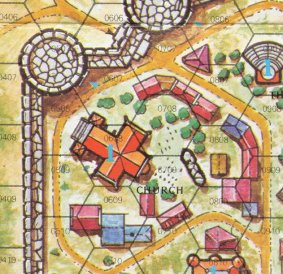
Original board map extract (© David Helber)
The smaller buildings style match the standard vector buildings from City designer 3, and the bigger building style match the buildings used in the Symbol Sets.
I started by fooling around with the software in order to get used to the basic functions such as objects, layers, rendering effects, creating grids, etc. Taking the time to learn your new tools beforehand usually pays off big time when you need to do real work.
The first step was to set up the grid, sea/river, and the board limits using tree symbols.
I placed an image of the original map in a background layer, and used it as a guide during the whole work. My goal was not to produce an exact copy of the original map, but I was careful to stay very close to the original to avoid any unwanted effects on gameplay. (Of course the final map was carefully playtested afterwards).
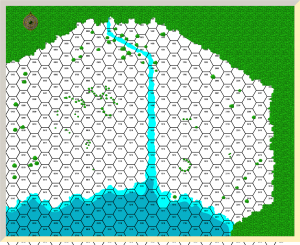
Initial grid and borders
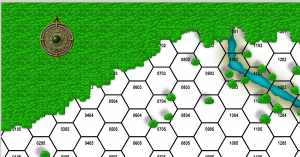
Detail
After that, I added the background layer, the walls and the roads.
The vegetation, walls, and houses are placed on different layers. This makes it easy to have them cast shadows of different length, for a better depth feeling : walls cast a bigger shadows than trees, and thus seem higher.
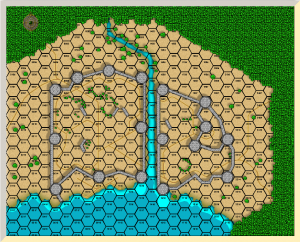
Adding the background, roads and walls
Some tweaking was required to get good results with the roads, water, and walls.
Until late in the map development, I used straight lines for the towers and walls, and only later did I experiment with dashes to get a better looking wall effect.
The towers are simple cylinders, and the wall simple lines using the built-in textures.
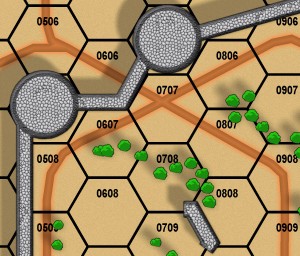
Detail
Next was the addition of some grass patches, and of all the houses in the city. Small houses use the CD3 vector house tool, and the bigger houses are bitmaps from the Symbol Set.
The bridges and wharfs are also bitmap symbols, and the walls tops have been converted to dashes.
Wall and tower doors have been added, from the Symbol Set too.
Last but not least, a text layer has been added to place the point value of the key buildings (in blue).
The hex grid was ‘exploded’ and manually tweaked around the western and eastern walls to match the original board grid. This is the kind of small features that save you hours of touch-up work and allow you great flexibility in your designs.
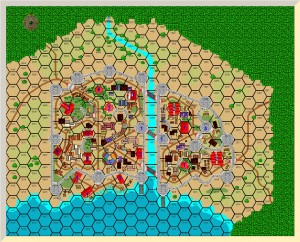
Adding the houses, bridges and wharfs (without fx)
With FX rendering turned on, the map really is taking shape : Glows give the water edges a dramatic effect, and are used to differentiate gates and doors in the wall and towers (blue/red) as this is an important information in game play.
All buildings have the same shadow size, to emphasize the walls height.
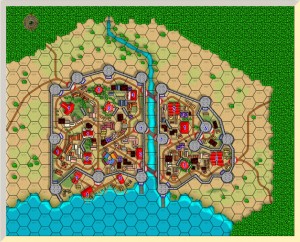
Now with fx
The last step was to tweak the hex grid colour (it is actually slightly transparent), add the building names and tweak the text layer’s appearance (using a light glow to improve legibility). The bridge images were changed in order to better differentiate stone and wooden bridges, and a lot of minor details were taken care of.
I then rendered the whole map, and cropped parts of that rendering to create the map legend using Inkscape and the Gimp (We’re a linux shop, with a windows box just for mapping). I also added the turn order track, logo and copyright attribution at this stage.
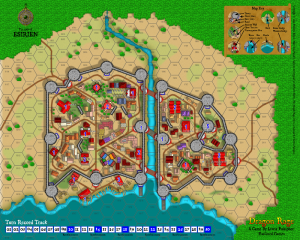
The Final Map : Esirien in all its glory
Mapping Nurkott
Most boardgame boards have only one side, and the other side is black of has a pattern on it. Production-wise, it costs the same to put another image on the back than a black sheet.
I immediately realized this was a good opportunity to provide more value to our customers : two boards instead of one, two games for the price of one!
I have played lots of tactical and skirmish games, and had a gut feeling of what could and couldn’t work for a second map. I investigated a few possibilities, then decided to make an ork oppidum. It would have lots of rivers and roads, allowing for interesting tactical options.
I’d use wooden palisades made of loosely jointed planks instead of stone walls, and make use of the terrain features to the residents’ advantage.
The first step was to make a rough draft of the map :
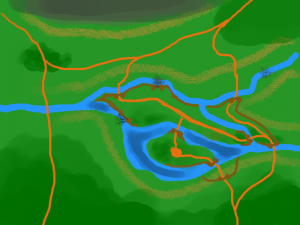
The first Nurkott rough
That rough image was imported in CD3 and quickly converted in a basic map using the same procedure as for Esirien : first the general map outline, then roads and water, background, and walls. All using different layers in order to be able to use different effects on each kind of objects.
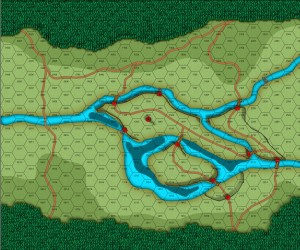
First step : the basic terrain features
Then, I added the housings and vegetation. Here again, a mix of vector houses from CD3 and bitmap symbols from the Symbol Sets were used.
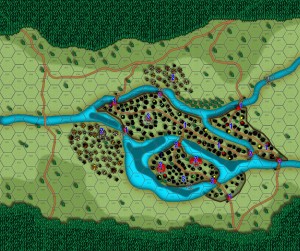
Step 2 : houses
Some minor tweaking was required for the water borders, to better integrate the map with the hex grid. I wanted to keep the original grid shape intact, contrary to the Esirien map.
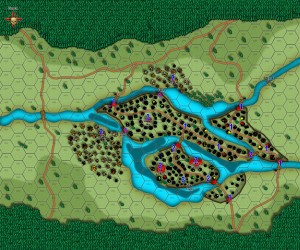
Step 3 : tweaking the map to the hex grid
The same techniques were used for the text layer. It’s quite amazing to see the level of detail you can get by zooming on the maps. Most of it is lost at print resolution as there is more details than can be printed, but every detail contributes to the overall results.
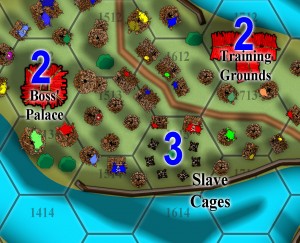
Island detail
That map was then playtested, and sent to lewis for further playtesting and approval.
I experimented with the background textures for the grass, the glows for the roads and river edges, and lots of little details such as changing the wooden bridge by a stone one after playtesting. Of course such changes would have been much more complex using an artist to draw the map. The legend was generated using the same method as above, as were the logo, turn order track and copyright credits.
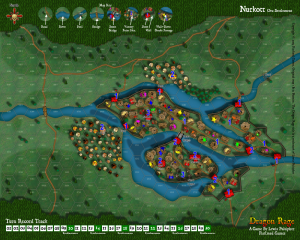
The final Nurkott map
Overall, using Profantasy Software proved a good business decision, and allowed me to put a quality product on the market.
You can learn more about Dragon Rage on our website : www.flatlinedgames.com
Eric Hanuise
Flatlined Games
2 Comments
Simon Rogers | October 27, 2011 |
There is a podcast interview with Ralf here with GMS Magazine – 14:00 in. They discuss using CC3 to create the Dragon Rage boardgame map (articles here), Dioramas, Fractal Terrains 3 and the Annuals. He also mentions the Tome – and Remy Monsen is working on a new version of that for our updated software.
Comments Off on Ralf Schemman at Spiel
Simon Rogers | June 9, 2011 | industry standard
Hi everyone!
I am Eric hanuise, from Flatlined Games.
In the beginning of this year, I published Dragon Rage, a game by Lewis Pulsipher, author of Britannia.
This release would not have been possible without the use of Campaign cartographer 3, City Designer 3 and the symbol sets.
Dragon Rage is an hex-and-counter wargame, that was first published in 1982 by Dwarfstar Heritage, a now long disappeared miniatures publisher.
When I licensed the game for republication with the author, I first tried to contact the original map artist, but without success.
I investigated several options to have the map re-created, and CC3/CD3 was THE solution to my woes.
Profantasy’s licensing agreement is a killer feature, there is no other map-making software on the market that allows commercial use of the software’s output, and has such high quality and consistent results.
Not only was I able to quickly recreate the original game board’s map with great precision, I was also able to create a second map to use on the board back, offering two games instead of just one!
Here is the original map, of Esirien, a walled city by the sea. in the game, the city is attacked by Dragons and other vile creatures, while humans defend it :
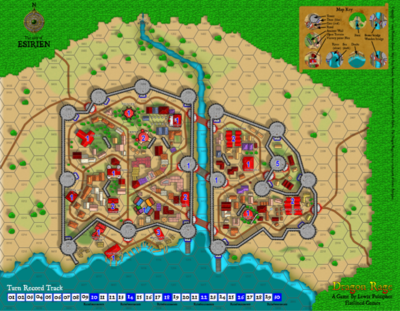
The combination of CD3 vector houses and bitmap symbols was just perfect to highlight the houses that serve as objectives in the game (with blue numbers).
The shading on the walls, trees and houses are on different heights and provide a realistic look to the map.
And here is the second map I created, Nurkott, an Orcish oppidum, attacked by Humans and various creatures :
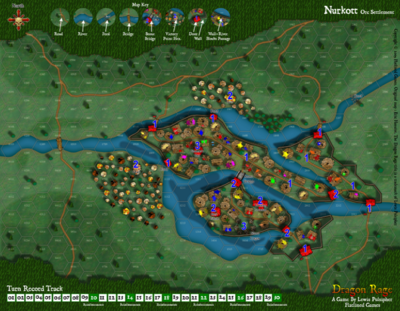
You can learn more about Dragon Rage on the game page on our website .
We at Flatlined Games were so impressed by CC3 and CD3 that we placed a ‘mapped with Campaign cartographer’ logo on the box’s back 🙂
1 Comment
ralf | October 31, 2019 | online gaming, vtt
Many of us have started playing role-playing games in high school, college or university and made great friends along the way. As life goes on we might move away from those friends and miss the good times of gaming around the table. One way to get at least part of this feeling back is to use modern technology to meet virtually and play via the Internet. While this can be done easily with generic online tools like Skype, Discord and similar options, quite a few developers have picked up the idea and offer software products tailored to this specific purpose, going so far as incorporating rules and tools for specific games making the experience as smooth as possible.
Many of these incorporate tools for sharing and using maps – either just for visual reference or to replace a gaming surface where you would have moved miniatures on. This is where it becomes especially interesting to us map-makers, as Campaign Cartographer 3+ and especially Dungeon Designer 3 are supremely suited to producing the maps for these software tools. Therefore I want to take a look at the various options out there and how they handle maps. They are not in any significant order, perhaps a vague sense of general popularity.
 Roll20
Roll20
Perhaps the most popular virtual tabletop option currently available, Roll20 is strongly aimed at d20-type games like Dungeons & Dragons, Pathfinder and 13th Age, but can be used with any other games as well. A listed of directly supported system can be found here. Its map feature allows you to import floorplans (e.g. created with DD3) as battle maps, use character or monster images as tokens on the map (e.g. from the Token Treasury) and includes dynamic lighting functionality for the maps.
A basic Roll20 account is free of charge, but you can pay for more privileged access and many types of resources for the game.
 Fantasy Grounds
Fantasy Grounds
Where Roll20 is a web-based application, Fantasy Grounds is a downloadable, stand-alone software, where one person is hosting with a GM account and the others join in with their client software. It has a very polished look with some beautiful design feature, like dice actually rolling across the virtual table, and also offers a large selection of different rules packages to choose from, which provide game-specific tools to facilitate the game.
Of course maps can also be imported into Fantasy Grounds, from overland maps to battle maps, including a grid feature to move virtual miniatures around. As you can set the size of the grid in Fantasy Grounds visually, it is very simple to add one on top of an existing Dungeon Designer 3 grid. But line of sight and dynamic lighting are limited.
Fantasy Grounds has a variety of pricing models, from a free demo version which lets you connect to a game hosted by someone with the most expensive version, to yearly subscriptions and one-time purchases.
 d20Pro
d20Pro
Another commercial offering, d20Pro also concentrates on the d20 family of rules as the name suggests, but can be expanded to other rules systems. The official D&D license as well as Pathfinder support feature prominently on the website.
Its map feature provides line of sight and fog of war effects and – as usual – importing images as maps. It also links to its own web-based map editor – World Engine – allowing limited map creation on the fly.
D20Pro’s pricing structure is simple (and fairly low) with just a player and a DM version of the license and a 30-day free trial.
 MapTool
MapTool
Another option is the free (donation-supported) MapTool. It is open source and the community provides a variety of extras, but of course it doesn’t have the kind of focused, system-specific support that the commercial competitors offer. IT can be very powerful if you dive into the open source framework to build your own system-support from the ground up, but that is quite a commitment.
Its map part does offer automated line of sight and fog of war features, making it convenient to use as virtual battlemap platform, without going into the kind of financial commitment other tools require.
 Astral
Astral
Astral is a purely web-based application including a fairly powerful map-making option. It doesn’t have official support for specific game systems, but provides basic assets for typical games (D&D, Cthulhu) with pre-made templates.
The basic version of Astral is free, but you need to pay for more online storage space, as well as additional assets for map-making, ambient sounds, etc.
Other tools
There is a variety of smaller tools around, and the VTT Wiki is good place to get a list and check them out. Or see this comparison of different vtts on Taking20.
2 Comments
ralf | November 3, 2016 | Annual, overland, Vandel
 Sweeping mountain ranges, trackless deserts, endless oceans and deep forests, that’s the stuff the Realms of Legend are made of. Fearless cartographers brave these mythic landscapes to chart the paths heroes must take to defeat ancient evils, soulless necromancers and barbarian plunderers.
Sweeping mountain ranges, trackless deserts, endless oceans and deep forests, that’s the stuff the Realms of Legend are made of. Fearless cartographers brave these mythic landscapes to chart the paths heroes must take to defeat ancient evils, soulless necromancers and barbarian plunderers.
TJ Vandel’s latest overland drawing style lets you create beautiful maps of the lands we have always loved in our games, where dragons roam, courageous princesses save their loved ones and the next treasure-filled dungeon is just around the corner. They are the Realms of Legend and your adventurers are just waiting for the right map to lead them there.
The November issue is designed to mesh well with August’s Scorching Sun and the upcoming Dark Realms style to give you a huge selection of symbols and textures to choose for your maps.
The issue is now available for CC3+ from the registration page for all subscribers. If you haven’t subscribed to the Annual 2016 yet, you can do so here.
Comments Off on Cartographer’s Annual: November Issue
ralf | October 27, 2016 | conv, essen, spiel
 October is the month of colorful trees, cold nights, autumn holidays… and SPIEL. The world’s largest consumer fair for boardgames takes place in Essen, Germany (in fact many visitors just call it “Essen” instead of “Spiel”). I’ve been manning the ProFantasy booth there since 2002, and it’s always a great opportunity to see old friends and many new games – though I rarely get to play any of the games.
October is the month of colorful trees, cold nights, autumn holidays… and SPIEL. The world’s largest consumer fair for boardgames takes place in Essen, Germany (in fact many visitors just call it “Essen” instead of “Spiel”). I’ve been manning the ProFantasy booth there since 2002, and it’s always a great opportunity to see old friends and many new games – though I rarely get to play any of the games.
Setup at SPIEL is usually quick, but there tend to be “surprises”. This year the convention center introduced a a new parking ticket system. It had a great advantage for setup, as we were able to get much closer to the booth with the car, but it would prove chaotic on the visitor days. Exhibitor parking got swamped and you had to be there very early to get into the garage under the center.
 “We” is usually me and Gordon, a stalwart friend and old-time CC3 user who always helps me with setting up and running the booth. His lovely wife and daughter use it as a base to tour the show – for the whole four days! It is so amazing to see what energy a six-year old can muster when she is surrounded by the wonders of the show. This year she didn’t even take a nap below the tables.
“We” is usually me and Gordon, a stalwart friend and old-time CC3 user who always helps me with setting up and running the booth. His lovely wife and daughter use it as a base to tour the show – for the whole four days! It is so amazing to see what energy a six-year old can muster when she is surrounded by the wonders of the show. This year she didn’t even take a nap below the tables.
SPIEL is different from GenCon in that is more about shopping and less about actually playing. Basically it’s one gigantic exhibitor’s hall without the events, seminars and gaming halls surrounding it. It’s also not so much about role- but about board-gaming, which is huge in Germany. Still we have a nice little corner of the even stocked with German and other (mostly British) rpg publishers.
 But the amount of visitors that shuffle through the halls on the weekend is staggering. In the bigger halls it can be really tough to get from one place to the next. Compared to that it was positively peaceful on our booth on Saturday – a bit surprising because it also tends to be busier for us. I am not sure why that this year – all days were pretty much as expected except for the Saturday. I wish I had a way to view measure the visitor paths through the halls – perhaps the “currents” got diverted from our place this year.
But the amount of visitors that shuffle through the halls on the weekend is staggering. In the bigger halls it can be really tough to get from one place to the next. Compared to that it was positively peaceful on our booth on Saturday – a bit surprising because it also tends to be busier for us. I am not sure why that this year – all days were pretty much as expected except for the Saturday. I wish I had a way to view measure the visitor paths through the halls – perhaps the “currents” got diverted from our place this year.
 But enough old and new customers showed up for us to have good business and great fun! I demoed CC3+ a lot, and especially the city and dungeon features caused many astonished and delighted comments. One very interesting development started last year: Chris, a lecturer from Brunel University (London), picked up CC3+ at SPIEL and introduced it to his Games Design class. It looks like that was very successful, meaning the university will pick up more software licenses – and I might get to give an introduction to CC3+ to the students myself. I’m excited and a bit scared, but very much looking forward to that.
But enough old and new customers showed up for us to have good business and great fun! I demoed CC3+ a lot, and especially the city and dungeon features caused many astonished and delighted comments. One very interesting development started last year: Chris, a lecturer from Brunel University (London), picked up CC3+ at SPIEL and introduced it to his Games Design class. It looks like that was very successful, meaning the university will pick up more software licenses – and I might get to give an introduction to CC3+ to the students myself. I’m excited and a bit scared, but very much looking forward to that.
Concerning my own gaming, I was positively frugal in my own shopping, but I did have a big piece to carry home: I picked up Perdition’s Mouth by Dragon Dawn Productions as payment for a little map I created for Timo Multamäki and his crew. I haven’t played it yet, but it does seem intriguingly different from your usual crop of dungeon crawlers.
And then the four days were over again. The halls close at 6pm on Sunday and our booth was all packed up 10 minutes past that – the advantage of easy-to-carry software over heavy books and huge boardgames. Luckily there are no flight that I can miss or be delayed on the way back from SPIEL, only a 1.5 hour Autobahn drive.

[Photo by Karl-Georg Müller (schlenderer.de)]
Comments Off on The Cartographer’s Travels: 4 Days of SPIEL
ralf | June 1, 2016 | 13th Age, characters
Recently we updated Character Artist 3 to be compatible with CC3+, and I jumped at the chance to work with that character builder again, doing some example drawings. I chose the characters from our 13th Age campaign, because they are such a great mix of classic (and not-so-classic) D&D-types.

Meet the heroes of Drakkenhall. Mostly these were easy to do with the basic Character Artist 3 options. The monster option has a lizard man figure that works great as a Dragonborn, and the halfling model doubles as a gnome just fine, if you skip the hairy feet.
 Some player-requested changes were quick and easy to make. “Abigail has red hair, not black!” – simple, just switch out the hair symbol for the correctly colored one. Others turned out a little more complicated. “Calor should have less full lips, but with a friendlier smile” – alright, I had to break out Photoshop for that and edit one of the mouth PNGs to create a new symbol. I drew the flames on the Dragonborn’s scimitar with CC3+’s vector tools and then applied a blur sheet effects.
Some player-requested changes were quick and easy to make. “Abigail has red hair, not black!” – simple, just switch out the hair symbol for the correctly colored one. Others turned out a little more complicated. “Calor should have less full lips, but with a friendlier smile” – alright, I had to break out Photoshop for that and edit one of the mouth PNGs to create a new symbol. I drew the flames on the Dragonborn’s scimitar with CC3+’s vector tools and then applied a blur sheet effects.
Overall I spent perhaps 15 minutes on each figure on average, plus another half hour composing the group shot. And while it certainly doesn’t match the players’ image of their own characters 100%, it’s still a nice visual impression of the group. I’m looking forward to their next exploits on the ruined streets of Drakkenhall!
P.S.: There is one special character that I indeed have to skip: P3358, the forgeborn fighter. That’s a character race, that CA3 does not support at the moment.
1 Comment
ralf | April 14, 2014 | books, world building
Author Nat Russo posted the following great article on “A Writer’s Journey” and graciously allowed us to repost it here. Enjoy his excellent advice and check out his book “Necromancer Awakening“.
Continue reading »
Comments Off on World Building Primer by Nat Russo
Clercon | December 10, 2012 | CD3, city, Par lindstrom

When I grew up I used to play a lot of Role playing games and especially I played a Swedish game called Drakar & Demoner (Dragons &Demons). Most of the adventures they released took place in a campaign world called Ereb Altor. At that time I thought the world was one of the coolest places for an adventure that existed, and I must say that the maps I saw then and the adventures I read really has influenced me a lot.
As I might have mentioned earlier making maps is my hobby, during the days I work as an IT-engineer, so mapping is something I do in my spare time. For that reason I’m very restrictive when it comes to taking up commissions, making maps for someone else means that I can’t make them for myself. But when I realized that the world Ereb Altor still was alive and that people still actually were working on new material I just couldn’t turn it down.
So after a short introduction to the people running the site I was asked to do a map of Kartotum, the capital city of Palinor. Making this city however turned out to a bit of a challenge. So far all of my city maps have been done in City Designer 3 (CD3) from Profantasy, a great program when it comes to make cities. However the program has its weak sides, and one of those is that it works best when it comes to making cities without too much elevation. Of course you can draw some elevation in the program, but not in a way that I wanted to do it.
You see Kartotum is situated on the slopes of a mountain so it is surrounded by great cliffs, and to draw that in CD3 was something way out of my league, if it’s even possible. So I decided to make the city and all the houses in CD3 and then draw the cliffs by using a combination of both Artrage pro and Photoshop. But to do this I first had to mark out the area in CD3 where the cliffs would be. To do this I added a green colour, different from the actual grassland, where I later would add the cliffs, as you can see in the map below. In this way I could place the symbols correctly in CD3.

When the city was done in CD3 I exported the map and opened it up in Photoshop. In Photoshop I added the black lines for the cliffs and saved the image as a .PSD file. The actual shadows around the lines I decided to add in Artrage Pro. The water colour brushes in that program are absolutely fantastic and in this way I could get the shadows exactly as I wanted them. I also added the colour of the cliffs in Artrage before opening the file in Photoshop again to add some finishing shadows and light effects.
Working on this commission has teached me a lot when it comes to adapting to some one else’s ideas and opinion and I must say that in some ways it’s even more relaxing doing maps for someone else than yourself. Suddenly you don’t need to come up with all the story and explanation to all the stuff you make. That is someone else’s headache.
Originally posted on mappingworlds.wordpress.com
Comments Off on Kartotum
Simon Rogers | January 10, 2012 | business
This post discusses business information which will probably not be of interest to most readers. Another article will cover our product development plans for 2012.
The Economy
 It was a tough time for the world economy, including the Eurozone, the UK and the USA, our primary market. My view is that while the economy has a negative effect on sales for many businesses, the effect of the economy on individual businesses is less pronounced than other factors, some of which are under the control of the business owners. Other businesses (Domino’s Pizza for example) positively benefit from downturns. Psychology suggests that we are much more likely to attribute positive results with our own endeavours, and negative results with external factors. So, anything I say here is pretty much speculation. Take the salt provided.
It was a tough time for the world economy, including the Eurozone, the UK and the USA, our primary market. My view is that while the economy has a negative effect on sales for many businesses, the effect of the economy on individual businesses is less pronounced than other factors, some of which are under the control of the business owners. Other businesses (Domino’s Pizza for example) positively benefit from downturns. Psychology suggests that we are much more likely to attribute positive results with our own endeavours, and negative results with external factors. So, anything I say here is pretty much speculation. Take the salt provided.
Our Sales
So this year, our UK sales in pounds were within a gnat’s whisker of 2010 and 2009, when adjusted for inflation. This is pretty good. I’d like to say it’s all down to our business choices, despite the downturn, but I think there is an element of the Domino’s Pizza about the roleplaying hobby – it’s one of the best-value pastimes there is. People get hours and hours of use of our of software and their games, and it’s a lot cheaper than going out. I’ve said facetiously that the RPG industry slogan should be “There’s never been a better time to enter a world of fantasy.”
Only a neglible fraction of our sales are through distribution, and this hasn’t changed. However, retail sales are disproportionately CC3, so it’s still worthwhile continuing this. Another interesting phenomenon is that while annual sales of CC3 (our entry product) increased by 6%, the average sale declined slightly as if to compensate.

We did release a new product – FT3 – but the upgrade was modestly priced, reducing our potential revenue, and because it’s such a widely accepted product among CC3 users, it was mainly upgrades. 2012 will be different – we’ve got three products in the pipeline.
Ralf says that convention sales are down a bit, but that overall the quality of maps has increased. Ralf and I think that the size of the table top roleplaying game market is stable, or even shrinking, but that the existing participants are older, wealthier and more committed than before. I am hoping that market leader Wizards of the Coasts new version of Dungeons and Dragons will expand the market, as that helps everyone.
The Website
Site visits increased about 30% since 2009, as has the average time on the site, the number of pages per visit. We achieved more than 450,000 unique visitors in 2011. We did a lot of work earlier in the year using Google Analytics to increase our conversion rate; it definitely increased as result, but nonetheless the conversion rate was lower than in 2010. I suspect that has more to do with the nature of the visitors, though I speculate that people are taking longer to decide and are spending their money more carefully. We updated our copy rather carefully, too, and have plans to revamp the website based on our recent poll.
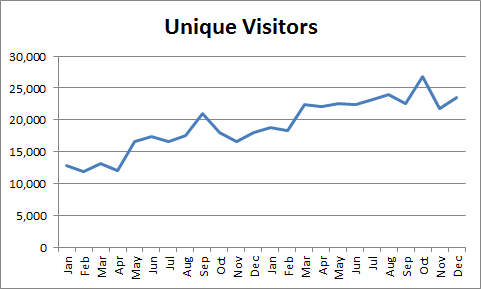
Other RPG Cartography Companies
It remains true that we are the only company producing cartography software for the RPG industry full time.
In our tiny industry, we think of other rpg map-makers as colleagues rather than rivals, so we were sad to see that, according to forum posts, Dundjinni has not been on sale for while. There has been no update since March last year. We’ve tried to reach the owner, Mindy, to no avail. It’s sad particularly because of the excellent community which built up around the software, creating new art which the CC3 community could also use. (This situation may change – I hope it does – so check their website to make sure.)
NBOS continues to produce Fractal Mapper, and Ed Diana released a new version of Astrosynthesis which he made compatible with the latest Fractal Terrains 3.
Miscellany
- There is a definite seasonal sales trend over the years. The spikes for product releases just about even out, though the Annual subscription helps our December sales disproportionately. I’d be very interested to hear if this pattern is repeated in other related companies.
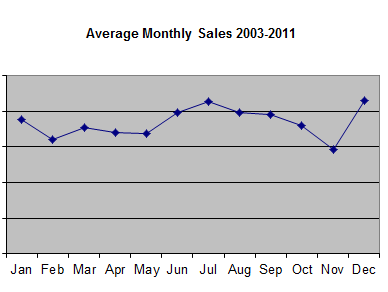
- The relative sales between the UK, USA and the rest of the world have remained unchanged now for at least three years.
- The proportion of download sales has increased from about 25% to 30% from 2010 to 2011
- We’ve sold to 92 countries in the past two years including Cameroon, Albania, and Reunion.
11 Comments































 It was a tough time for the world economy, including the Eurozone, the UK and the USA, our primary market. My view is that while the economy has a negative effect on sales for many businesses, the effect of the economy on individual businesses is less pronounced than other factors, some of which are under the control of the business owners. Other businesses (Domino’s Pizza for example) positively benefit from downturns. Psychology suggests that we are much more likely to attribute positive results with our own endeavours, and negative results with external factors. So, anything I say here is pretty much speculation. Take the salt provided.
It was a tough time for the world economy, including the Eurozone, the UK and the USA, our primary market. My view is that while the economy has a negative effect on sales for many businesses, the effect of the economy on individual businesses is less pronounced than other factors, some of which are under the control of the business owners. Other businesses (Domino’s Pizza for example) positively benefit from downturns. Psychology suggests that we are much more likely to attribute positive results with our own endeavours, and negative results with external factors. So, anything I say here is pretty much speculation. Take the salt provided.

